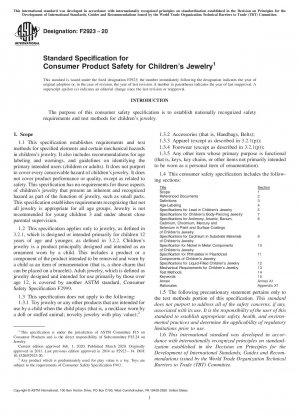ASTM F2923-20
Standard Specification for Consumer Product Safety for Children’s Jewelry
- Standard No.
- ASTM F2923-20
- Release Date
- 2020
- Published By
- American Society for Testing and Materials (ASTM)
- Latest
- ASTM F2923-20
- Scope
- 1.1 This specification establishes requirements and test methods for specified elements and certain mechanical hazards in children’s jewelry. It also includes recommendations for age labeling and warnings, and guidelines on identifying the primary intended users (children or adults). It does not purport to cover every conceivable hazard of children’s jewelry. It does not cover product performance or quality, except as related to safety. This specification has no requirements for those aspects of children’s jewelry that present an inherent and recognized hazard as part of the function of jewelry, such as small parts. This specification establishes requirements recognizing that not all jewelry is appropriate for all age groups. Jewelry is not recommended for young children 3 and under absent close parental supervision. 1.2 This specification applies only to jewelry, as defined in 3.2.1, which is designed or intended primarily for children 12 years of age and younger, as defined in 3.2.2. Children’s jewelry is a product principally designed and intended as an ornament worn by a child. This includes a product or a component of the product intended to be removed and worn by a child as an item of ornamentation (that is, a shoe charm that can be placed on a bracelet). Adult jewelry, which is defined as jewelry designed and intended for use primarily by those over age 12, is covered by another ASTM standard, Consumer Safety Specification F2999. 1.3 This specification does not apply to the following: 1.3.1 Toy jewelry or any other products that are intended for use by a child when the child plays (that is, a necklace worn by a doll or stuffed animal; novelty jewelry with play value);2 1.3.2 Accessories (that is, Handbags, Belts); 1.3.3 Apparel (except as described in 3.2.1(p)); 1.3.4 Footwear (except as described in 3.2.1(p)); 1.3.5 Any other item whose primary purpose is functional (that is, keys, key chains, or other items not primarily intended to be worn as a personal item of ornamentation). 1.4 This consumer safety specification includes the following sections: Title Section Scope 1 Referenced Documents 2 Definitions 3 Age-Labeling 4 Specifications for Lead in Children’s Jewelry 5 Specifications for Children’s Body-Piercing Jewelry 7 Specifications for Antimony, Arsenic, Barium, Cadmium, Chromium, Mercury and Selenium in Paint and Surface Coatings of Children’s Jewelry 8 Specifications for Cadmium in Substrate Materials of Children’s Jewelry 9 Specification for Nickel in Metal Components of Children’s Jewelry 10 Specification for Phthalates in Plasticized Components of Children’s Jewelry 11 Specifications for Liquid-Filled Children’s Jewelry 12 Mechanical Requirements for Children’s Jewelry 13 Test Methods 14 Keywords 15 Annex Annex A1 Rationales Appendix X1 1.5 The following precautionary statement pertains only to the test methods portion of this specification. This standard does not purport to address all of the safety concerns, if any, associated with its use. It is the responsibility of the user of this standard to establish appropriate safety, health, and environmental practices and determine the applicability of regulatory limitations prior to use. 1.6 This international standard was developed in accordance with internationally recognized principles on standardization established in the Decision on Principles for the Development of International Standards, Guides and Recommendations issued by the World Trade Organization Technical Barriers to Trade (TBT) Committee. 1 This specification is under the jurisdiction of ASTM Committee F15 on Consumer Products and is the direct responsibility of Subcommittee F15.24 on Jewelry. Current edition approved Feb. 1, 2020. Published March 2020. Originally approved in 2011. Last previous edition approved in 2014 as F2923 – 14. DOI: 10.1520/F2923-20. 2 Any product which is predominately used for play value is a toy. Toys are subject to the requirements of Consumer Safety Specification F963. Copyright © ASTM International, 100 Barr Harbor Drive, PO Box C700, West Conshohocken, PA 19428-2959. United States This international standard was developed in accordance with internationally recognized principles on standardization established in the Decision on Principles for the Development of International Standards, Guides and Recommendations issued by the World Trade Organization Technical Barriers to Trade (TBT) Committee. 1 2. Referenced Documents
ASTM F2923-20 Referenced Document
- ASTM E1613 Standard Test Method for Determination of Lead by Inductively Coupled Plasma Atomic Emission Spectrometry (ICP-AES), Flame Atomic Absorption Spectrometry (FAAS), or Graphite Furnace Atomic Absorption Spectrometry (GFAAS) Techniques
- ASTM F2999 Standard Consumer Safety Specification for Adult Jewelry
- ASTM F963 Standard Consumer Safety Specification for Toy Safety
ASTM F2923-20 history
- 2020 ASTM F2923-20 Standard Specification for Consumer Product Safety for Children’s Jewelry
- 2014 ASTM F2923-14 Standard Specification for Consumer Product Safety for Children’s Jewelry
- 2011 ASTM F2923-11 Standard Specification for Consumer Product Safety for Childrenx2019;s Jewelry
